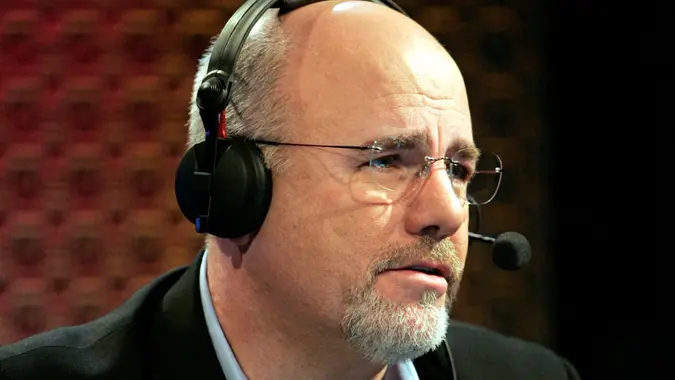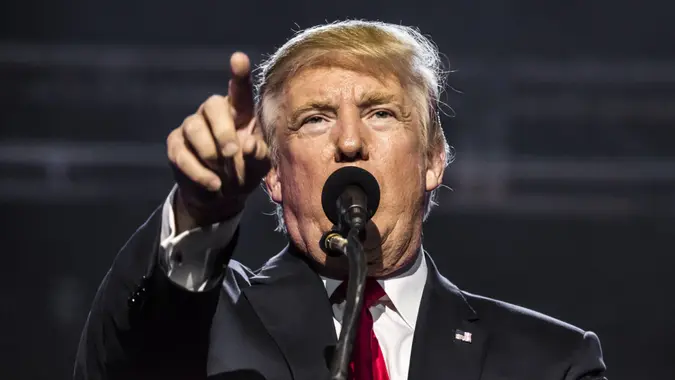Trump’s $2K Dividend: What Low-Income Americans Should Expect

Commitment to Our Readers
GOBankingRates' editorial team is committed to bringing you unbiased reviews and information. We use data-driven methodologies to evaluate financial products and services - our reviews and ratings are not influenced by advertisers. You can read more about our editorial guidelines and our products and services review methodology.

20 Years
Helping You Live Richer

Reviewed
by Experts

Trusted by
Millions of Readers
On Aug. 3, Reuters reported that President Donald Trump said his tariffs were bringing in so much money that there could be a distribution or dividend sent out to Americans, particularly targeting those in the middle- and lower-income groups.
More details have emerged in the ensuing months, most notably, an enticing dollar amount — $2,000. However, there are still more questions and quandaries than concrete answers.
Here’s what qualifying recipients of the hypothetical tariff dividend payment could expect.
What Is a Dividend and Where Would the $2K Come From?
In investing, dividends are portions of company profits that corporations pay to shareholders.
In this case, the corporation would be the U.S. Treasury, which collects revenue from tariffs — or taxes — imposed on imports.
According to Tax Foundation, the tariffs have raised $174 billion in revenue through September 2025. Trump’s position is that the proceeds should be redistributed back to the American taxpayer as a windfall.
There’s Still No Official Measure of ‘Low Income’
The administration has consistently stated that the dividend would be reserved for low-income and moderate-income taxpayers, but it has never specified who fits this criteria. On Nov. 12, Treasury Secretary Scott Bessent suggested $100,000 might be the income cutoff in a “Fox and Friends” interview. However, when the interviewer asked if that had been finalized, Bessent replied that it had not.
Don’t Expect a COVID-Era Stimulus Check
Those hoping for a pandemic-style check or direct deposit of funds to their bank account should temper their expectations.
In an interview on ABC’s “This Week,” Bessent appeared to publicly contradict Trump’s promise of “at least $2,000” to all Americans, except for high earners, in the form of a dividend-style payment.
When pressed for details, the Treasury secretary said recipients would probably collect in the form of tax cuts — some of which are already law and exclude many Americans — including:
- Eliminated tax on tips
- Overtime tax elimination
- Ending the tax on Social Security
- Auto loan deductions
As of Now, the Math Doesn’t Add Up
If the president’s own Treasury secretary is publicly hedging, it’s likely because Trump has made a promise that may prove difficult to keep.
The primary problem is arithmetic.
The IRS reported that 141 million Americans filed tax returns in 2025 for the 2024 tax season. Even if every single dollar from the $174 billion in tariff revenue were seamlessly distributed to all taxpayers, that would amount to $1,234 per household, far from the $2,000 mark.
There Are Far More Obstacles Than Answers
While most would welcome a $1,200-plus windfall, they shouldn’t expect it — or at least not all of it — because:
- The president can’t waive a stimulus wand: The U.S. Customs and Border Protection collects duties from importers and sends it to the U.S. Treasury’s general fund, where it is then appropriated by Congress — not the president — for government spending.
- It would require borrowing: With too little tariff revenue to distribute the promised $2,000, Congress would have to borrow against future tariff revenue — which the Tax Foundation projected will be between $1.8 trillion and $2.4 trillion over the next decade — to fill the gap. Despite the GOP’s control of the House and Senate, that will be a tough sell to lawmakers who ran on fiscal responsibility and are facing a difficult upcoming midterm election.
- There might be no future tariff revenue to borrow against: The AP reported that a majority of justices appear skeptical of the legality of Trump’s sweeping tariff policy in a crucial case the Supreme Court is currently hearing.
- Consumers pay for tariffs at checkout: Since importers pass the cost of tariffs onto consumers in the form of higher prices, the Tax Foundation estimated that the average household lost between $1,200 and $1,600 in income due to tariffs in 2025 and 2026, while the Yale Budget Lab cites a loss of $1,800. Even if all Americans received the full $2,000, the cumulative gain would be only between $200 and $800.
Editor’s note on political coverage: GOBankingRates is nonpartisan and strives to cover all aspects of the economy objectively and present balanced reports on politically focused finance stories. You can find more coverage of this topic on GOBankingRates.com.
More From GOBankingRates
 Written by
Written by  Edited by
Edited by 

























